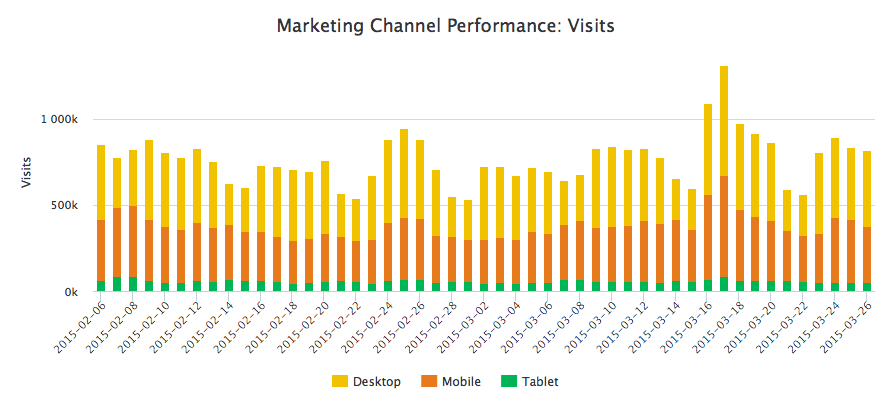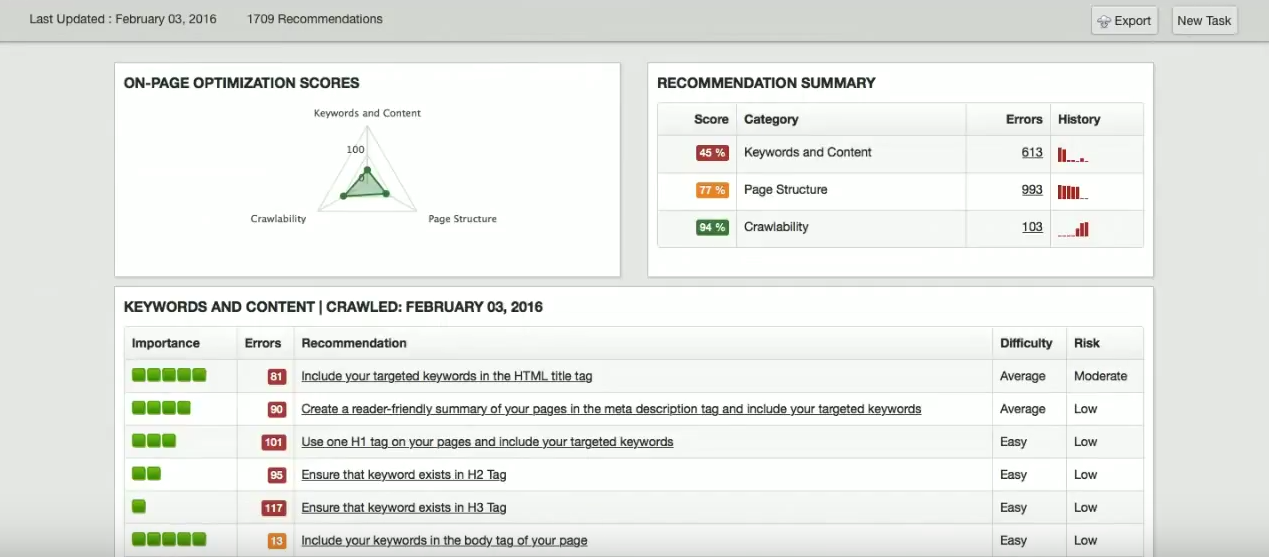As with any rapidly growing market, the terms associated with the tools and best practices of marketing analytics have become less differentiated and often confused. Talking about SEO, search, data, analytics, insights, and recommendations interchangeably is confusing. Even worse, it can be misleading when you’re looking for specific tools or discussing particular outputs. To help clarify, below we’ll talk about some of the more commonly confused or misused terms.
The difference between SEO and search
As SEO enters into conversations about content marketing, a common confusion is the difference between SEO and search. Search is most often referring to data related to search- and it’s important to distinguish whether it means paid versus organic. SEO is the methodology behind optimizing sites and their content to be found by search engines. These terms are confused at times and can mean inaccurate or incomplete use of data or choosing a tool that doesn’t completely meet your needs.
SEO encompasses the techniques, strategies, and tactics used to increase the number of organic visitors to a site by improving a brand’s findability. Findability is improved when the content created by a brand is ranked higher on a search results page (SERP) and more visible to search engine users. SEO does not include improvements to paid efforts and is often focused on the page structure, crawlability, keywords and content for pages on your site.
The difference between data and analytics
Let’s talk a little bit about how people may use data, analytics, and insights interchangeably and why that can be a source of confusion. Data is the collection of facts and statistics for reference or analysis. It’s easiest to picture data as the building blocks or the individual pieces. If you think of data as the Legos, you can see how they are the individual pieces that are used in conjunction with other individual pieces to build a picture to show results.
Analytics are the tools that provide the analysis of the data or statistics. Using the Legos analogy, once all the pieces have been collected, analytics looks at the picture they’ve created to understand the significance of the data.
The analysis phase often involves studying historical data to find trends, finding the causality of actions, or evaluating the performance of marketing efforts. Analytics may be used to determine the effectiveness of a marketing campaign, a messaging strategy, a particular scenario, or a tool. Analytics is used to look at a range of data to inform strategic decisions. Most of the time, when someone is looking for a platform, they’re not simply looking for data – as it’s often in such high volume that it cannot be interpreted without some form of analysis first.
As we continue to hear the term “big data” thrown around, it’s important to understand the difference between “big” and “small” data and some conditions for meeting each.
Typically people think big data refers to the millions and billions of pieces of data that they may have – seeing as purely a matter of volume. Although volume is a factor in determining data’s “bigness” – there are three core things to look at when determining if you’ve got really got “big data”:
- Condition — This is the cleanliness of the data. An example of this would be a list of email addresses from current customers that has been checked for unsubscribes, valid and current addresses, etc., would considered “clean.” To be small data, it must be clean. Conversely, a purchased email list that has yet to be validated (correct address, on target, willing to receive messages from you) may be considered “big data” because it requires time and manpower or tools to check.
- Location — This refers to where the data is coming from and how compatible it is with the final format you need it to be in. Data that requires merging from multiple sources in a variety of formats or with differing variables is “big data.” If you take our email example, if you have a list of users saved in an email management program, such as MailChimp or Marketo, and it’s ready to have emails sent immediately, that is considered “small data,” whereas if you have to merge multiple sources together and reformat them to get them into your email management tool, that can make this “big data.”
- Population — This refers to the individuals that have qualities in common to the need in consideration. Sticking with the email example, “small data” is comprised of a known population that is not expected to have changes to its composition in the short term. This allows marketers to use this data to answer a specific question or need now. Conversely, “big data” would represent a large purchased email list that includes unknown addresses, possible duplications, unsubscribes or irrelevant targets. This list cannot be used for targeted email marketing sends in its current form (at least not by a good marketer) and must be “cleaned” first.
A good way to think about this is that if you had a list of one million known customers in a list with valid, up to date information, already loaded into your email management system — sending them an email would be a snap. Conversely, a list of 100 people with invalid email addresses, unknown recipients or formatting problems would take more time to clean and work with than that list of one million conditioned people.

Rank Tracking & Competitor Insights Delivered Daily
The difference between analytics and insights
While analytics or analysis provide the means to look at data over time, or by campaign, insights are the take-aways you garner from the analysis. The insights gathered through analysis help to form an accurate understanding of a situation, scenario, or in some cases, a person. Whether we’re talking about insights about your target market, insights about marketing or SEO performance, or insights about specific contributions to an overall effort, insights are the things you derive from analyzing the data.
For most people, insights are really what they’re looking for from a tool. These are the actionable items that you include in your paid advertising, social media, public relations, e-mail, content marketing, and other strategic plans. Insights are the specific pieces of information you can use to decide what content to create next or to understand why a competitor it outranking you in the SERPs or taking share of voice on social media.
 Recommendations defined
Recommendations defined
Recommendations are suggestions or proposals about the best course of action. The recommendations you accept in any situation are those put forth by somebody who you think is an authority.
In the case of tools, recommendations are often presented as a laundry list of tactics that should be employed to improve search results. In larger platforms, these recommendations may be categorized by difficulty, risk, and importance. You may also be able to segment them by keyword or content groups to help prioritize which recommendations you’ll tackle first.
The important difference – data, analytics, and insights
While the differences between analytics and insights may seem insignificant, it’s important to frame any conversation you’re having about a platform and the results you can expect to achieve. Most people probably aren’t looking for a data platform or an analytics platform. They don’t want just raw data or just analytics. What they’re actually looking for are insights and recommendations, actionable next steps to help them improve current and future efforts and positively impact the bottom line. It’s important to make the distinction between data, analytics, insights, and recommendations to ensure the person you’re talking to can accurately guide you to find the best match for your needs.
Accurately using terms to explain to stakeholders will improve your ability to explain what your organization will get out of a new tool. Depending on your organization, you may only need raw data or some analytics because you have a really big business intelligence department or strategic or analytics department that can provide the insights and recommendations.
On the other hand, smaller teams may need a tool that does all the heavy lifting and provides insights and recommendations along with next steps. Your goals for a platform may be to get specific recommendations about next steps without the need to see the granular data behind the recommendations.
Watch the YouTube video here:
